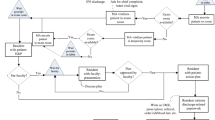Abstract
We report on the use of discrete event simulation modeling to support process improvements at an orthopedic outpatient clinic. The clinic was effective in treating patients, but waiting time and congestion in the clinic created patient dissatisfaction and staff morale issues. The modeling helped to identify improvement alternatives including optimized staffing levels, better patient scheduling, and an emphasis on staff arriving promptly. Quantitative results from the modeling provided motivation to implement the improvements. Statistical analysis of data taken before and after the implementation indicate that waiting time measures were significantly improved and overall patient time in the clinic was reduced.






Similar content being viewed by others
References
Noon CE, Hankins CT, Cote MJ (2003) Understanding the impact of variation in the delivery of healthcare services. J Healthc Manag 48:82–98
McCarthy K, McGee HM, O’Boyle CA (2000) Outpatient clinic waiting times and non-attendance as indicators of quality. Psych Health Med 5:287–293
Blizzard R (2009) Patient satisfaction starts in the waiting room. Gallup Poll News Service, July 15
Cartwright A, Windsor J (1992) Outpatients and their doctors. HMSO, London
Huang XM (1994) Patient attitude towards waiting in an outpatient clinic and its applications. Health Serv Manag Res 7:2–8
Hart M (1995) Improving out-patient clinic waiting times: methodological and substantive issues. Int J Health Care Qual Assur 8:14–22
Katz KL, Larson BM, Larson RC (1991) Prescription for the waiting-in-line blues: entertain, enlighten and engage. Sloan Manage Rev 32:44–53
Walley P, Silvester K, Mountford S (2006) Health-care process improvement decisions: a systems perspective. Int J Health Care Qual Assur 19:93–104
Law AM, Kelton WD (2000) Simulation modeling & analysis, 3rd edn. McGraw-Hill, Inc., New York
Jun J, Jacobson S, Swisher J (1999) Application of discrete-event simulation in health care clinics: a survey. J Oper Res Soc 50:109–123
Ledlow GR, Bradshaw DM (1999) Animated simulation: a valuable decision support tool for practice improvement. J Healthc Manag 44:91–101
Young T (2005) An agenda for healthcare and information simulation. Health Care Manag Sci 8:189–196
Cooper K, Brailsford SC, Davies R (2007) Choice of modelling technique for evaluating health care interventions. J Oper Res Soc 58:168–176
Kumar A, Shim SJ (2005) Using computer simulation for surgical care process reengineering in hospitals. INFOR 43:303–319
VanBerkel PT, Blake JT (2007) A comprehensive simulation for wait time reduction and capacity planning applied in general surgery. Health Care Manag Sci 10:373–385
Kim S-C, Horowitz I, Young KK, Buckley TA (2000) Flexible Bed allocation and performance in the intensive care unit. J Oper Manag 18:427–443
Rohleder TR, Bischak DP, Baskin LB (2007) Modeling patient service centers with simulation and system dynamics. Health Care Manag Sci 10:1–12
Brasted C (2008) Ultrasound waiting lists: rational queue or extended capacity? Health Care Manag Sci 11:196–207
Merkle JF (2002) Computer simulation: a methodology to improve the efficiency in the brooke army medical center family care clinic. J Healthc Manag 47:58–67
Sachdeva R, Williams T, Quigley J (2007) Mixing methodologies to enhance the implementation of healthcare operational research. J Oper Res Soc 58:159–167
ExpertFit (2002) Averill M. Law and Associates
Alexopoulos C, Goldsman D, Fontanesi J, Kopald D, Wilson JR (2008) Modeling patient arrivals in community clinics. Omega 36:33–43
Klassen KJ, Rohleder TR (1996) Scheduling outpatient appointments in a dynamic environment. J Oper Manag 14:83–101
Pittet D, Simon A, Hugonnet S, Pessoa-Silva CL, Sauvan V, Perneger TV (2004) Hand hygiene among physicians: performance, beliefs, and perceptions. Ann Intern Med 14:1–8
Scott T, Mannion R, Davies HT, Marshall MN (2003) Implementing culture change in health care: theory and practice. Int J Qual Health Care 15:111–118
Luthans KW, Lebsack SA, Lebsack RR (2008) Positivity in healthcare: relation of optimism to performance. J Health Org Manag 22:178–187
Klassen R, Leitch K, Hora M (2008) Paediatric orthopaedic clinic at the Children’s Hospital of Western Ontario. Richard Ivey School of Business Case Study, Ivey Management Services (A) 2008-12-23
Acknowledgements
We wish to thank the following individuals for their assistance with this research: Taurean Berger, Andrew Hartman, Megan Macadam, and Nolan Sontag. We also thank Bev Campbell and the staff of the Orthopaedic Clinic at the Foothills Medical Center. The third author's research was supported by the Natural Sciences and Engineering Research Council of Canada under Grant No. 239153-05.
Author information
Authors and Affiliations
Corresponding author
Rights and permissions
About this article
Cite this article
Rohleder, T.R., Lewkonia, P., Bischak, D.P. et al. Using simulation modeling to improve patient flow at an outpatient orthopedic clinic. Health Care Manag Sci 14, 135–145 (2011). https://doi.org/10.1007/s10729-010-9145-4
Received:
Accepted:
Published:
Issue Date:
DOI: https://doi.org/10.1007/s10729-010-9145-4




